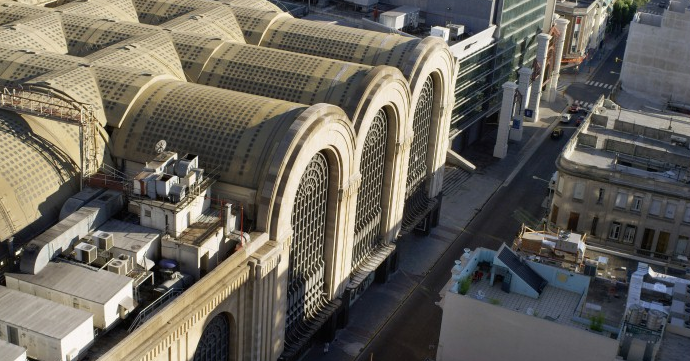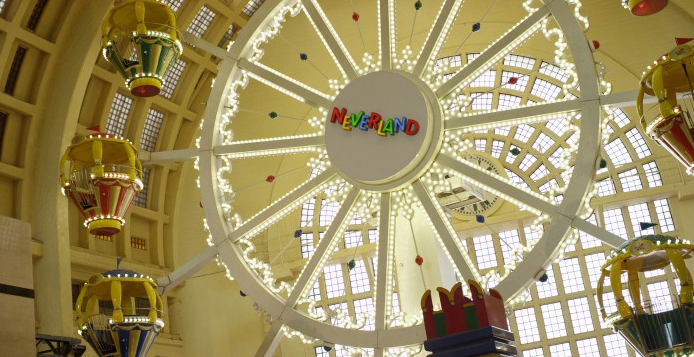This week I am thrilled to welcome SAIC student Sidney Tilghman to the blog! Sidney highlights the ways Heinz Emigholz’s film The Airstrip explores modernity through a wide array of structures ranging from airports to shopping malls from Wrocław, Poland to Mexico City, Mexico.

Like many of Heinz Emigholz’s films, The Airstrip (2013) unspools in a specific juncture of time and space, bridging film, architecture, and the idea of a collective history. The twenty-first installment of a larger project titled “Photography and Beyond,” Emigholz opens with a quote describing the midpoint between the moment of a bomb’s release and its point of impact. He follows this with images of Reinhold Begas’s “Prometheus in Chains” (1899) and a discussion of the legend of Prometheus in relation to the shaping of modern Germany, narrated by Natja Brunkhorst. The story of Prometheus, like that of prewar Europe, is one of creation, destruction, and retribution, an apt analogy for the events leading up to and following the mass devastation of World War II.
Framed largely in the aftermath of the atomic bomb, The Airstrip invites audiences to trace the trajectory of Modernism on a global scale. Airports, department stores, markets, grand halls, monuments, cathedrals, a stadium and a prison comprise just a portion of the series of structures Emigholz shoots. His locations vary–ranging from nations largely untouched by the physical destruction of the Second World War to the enshrined loading pits of the Enola Gay and eroded caissons off the beaches of Normandy. Emigholz examines these structures as they stand today–some abandoned, some repurposed, a few humming with activity, others forgotten and cordoned off.

At times, frames appear to be still photogaphs rather than moments captured on film. Ambient noise and shifting light, the passing bus or rogue pigeon, remind us that we are firmly rooted in progressing action. More often than not, Emigholz’s images stray from the traditional format of architectural photography and instead focus on angled perspectives and a sequence of details–the curve of a rail, an abstracted concrete form, a mirrored wall, iron beams–all the repetitious elements that onstitute our modern buildings. Lounging tourists, neon reflections, fast food signs, and passing glimpses of buses and cars occasionally interrupt these meditations, anchoring each structure to the world we currently experience and occupy.
The progressions of shots are frequently evocative of the path of the spectator’s eye, allowing viewers three to five seconds of observation before flitting to another detail, another room, or a different view. The effect is one that demonstrates Emigholz’s aim of narrating the path of human activity and history through a specific building or space. His presentations of these architectural works become mirrors of the structures themselves–at once fleeting, ephemeral, banal, commercialized, commodified, melancholic, and in constant confluence with the cities and urban centers surrounding them. Thus, the film goes beyond mere documentation of Modern design and expands to themes of history, collective memory, fantasy, utopias, and impact of our erroneous past in relation to our negligent present.
The Airstrip has no immense finale, no finite conclusion, no grandiose denouement. Rather, Emigholz offers his audience a version of Modernism that is exceptionally different from the one that we so often accept as history. His is an account of the rise of dictators and fall of nations, mass-production fueled by mass-consumption, and stadiums turned slaughterhouses. Emigholz leaves us at the Neptune Fountain in Berlin, a lapidary masterwork sandwiched between the Red City Hall (1861-1869, 1951-1956) and the Berlin TV Tower (1969). As the frames move from one view of the fountain to another, we are reminded again of the role of classicism; not only in relation to the Modern ideal but also in regards to the dangerous ideologies it inspired.

Sidney Tilghman is currently pursuing a Bachelor of Fine Arts at the School of the Art Institute of Chicago. Her studio practice is largely based in printmedia and sculpture, however she has also taken courses in creative nonfiction as well as architectural theory and criticism. In her private life, Sidney is a devoted reader, avid tennis player, ardent supporter of Soylent products, and devotes much of her time to thinking of her dog, Radar.